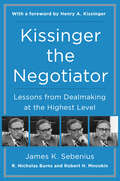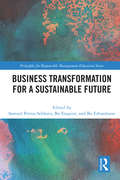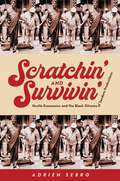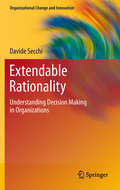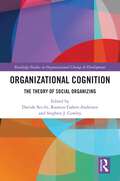- Table View
- List View
Kissinger the Negotiator: Lessons from Dealmaking at the Highest Level
by James K. Sebenius R. Nicholas Burns Robert H. MnookinForeword by Henry KissingerIn this groundbreaking, definitive guide to the art of negotiation, three Harvard professors—all experienced negotiators—offer a comprehensive examination of one of the most successful dealmakers of all time.Politicians, world leaders, and business executives around the world—including every President from John F. Kennedy to Donald J. Trump—have sought the counsel of Henry Kissinger, a brilliant diplomat and historian whose unprecedented achievements as a negotiator have been universally acknowledged. Now, for the first time, Kissinger the Negotiator provides a clear analysis of Kissinger’s overall approach to making deals and resolving conflicts—expertise that holds powerful and enduring lessons.James K. Sebenius (Harvard Business School), R. Nicholas Burns (Harvard Kennedy School of Government), and Robert H. Mnookin (Harvard Law School) crystallize the key elements of Kissinger’s approach, based on in-depth interviews with the former secretary of state himself about some of his most difficult negotiations, an extensive study of his record, and many independent sources. Taut and instructive, Kissinger the Negotiator mines the long and fruitful career of this elder statesman and shows how his strategies apply not only to contemporary diplomatic challenges but also to other realms of negotiation, including business, public policy, and law. Essential reading for current and future leaders, Kissinger the Negotiator is an invaluable guide to reaching agreements in challenging situations.
Steve Perlman and WebTV (A)
by James K. Sebenius Ron S. FortgangThe dynamics of a linked series of internal and external negotiations involved in launching, growing, and selling a high-tech, Internet start-up are explored. Steve Perlman unfurled an impressive new technology, recruited a top technical and management team, secured seed capital, laid the groundwork for later stages of financing, initiated alliances with content and Internet service providers, maneuvered into negotiation with major consumer electronics players Sony and Philips (for manufacturing and distribution), and ultimately had to decide on his strategy for possibly selling the firm. WebTV provided a low-cost, easy-to-use set-top box that linked televisions to the Internet, allowing users instant web access.
Henry A. Kissinger as Negotiator: Background and Key Accomplishments
by James K. Sebenius Laurence A. GreenCase
Henry Kissinger: Negotiating Black Majority Rule in Rhodesia (A)
by James K. Sebenius Laurence A. GreenIn 1976, a growing crisis in Southern Africa drew the attention of United States Secretary of State Henry A. Kissinger. White Rhodesian leader Ian Smith's refusal to accede to black majority rule threatened to widen into a regional conflict involving apartheid South Africa and newly independent leftist African states. Kissinger and others feared that the region was on the brink of becoming a new battleground in the Cold War. In light of these developments Kissinger decided to intervene, seeking a negotiated solution that might bring about a peaceful end to minority rule. The account in this case carefully describes—but does not analyze nor draw lessons from—these challenging circumstances.
Henry Kissinger: Negotiating Black Majority Rule in Rhodesia (B)
by James K. Sebenius Laurence A. GreenIn 1976, United States Secretary of State Henry A. Kissinger conducted a series of intricate, multiparty negotiations in Southern Africa to persuade white Rhodesian leader Ian Smith to accede to black majority rule. Conducted near the end of President Gerald Ford’s term in office and against substantial U.S. domestic opposition, Kissinger’s efforts culminated in Smith’s public announcement that he would accept majority rule within two years. This set the stage for the later Lancaster House negotiations that resulted in the actual transition to black majority rule. The account in this case carefully describes—but does not analyze nor draw lessons from—these challenging negotiations.
Henry Kissinger: Negotiating Black Majority Rule in Rhodesia (A)
by James K. Sebenius Laurence A. GreenIn 1976, a growing crisis in Southern Africa drew the attention of United States Secretary of State Henry A. Kissinger. White Rhodesian leader Ian Smith's refusal to accede to black majority rule threatened to widen into a regional conflict involving apartheid South Africa and newly independent leftist African states. Kissinger and others feared that the region was on the brink of becoming a new battleground in the Cold War. In light of these developments Kissinger decided to intervene, seeking a negotiated solution that might bring about a peaceful end to minority rule. The account in this case carefully describes-but does not analyze nor draw lessons from-these challenging circumstances.
Henry Kissinger: Negotiating Black Majority Rule in Rhodesia (B)
by James K. Sebenius Laurence A. GreenIn 1976, United States Secretary of State Henry A. Kissinger conducted a series of intricate, multiparty negotiations in Southern Africa to persuade white Rhodesian leader Ian Smith to accede to black majority rule. Conducted near the end of President Gerald Ford's term in office and against substantial U.S. domestic opposition, Kissinger's efforts culminated in Smith's public announcement that he would accept majority rule within two years. This set the stage for the later Lancaster House negotiations that resulted in the actual transition to black majority rule. The account in this case carefully describes-but does not analyze nor draw lessons from-these challenging negotiations.
Craft a 3-D Strategy to Overcome the Barriers: The Components of 3-D Negotiation
by James K. Sebenius David A. LaxIn this chapter, the authors describe how to overcome the barriers to agreement that your 3-D audit has identified by crafting a strategy that aligns the three dimensions of effective negotiation: setting up the right negotiation, designing value-creating deals, and stressing problem-solving tactics.
Do a 3-D Audit of Barriers to Agreement
by James K. Sebenius David A. LaxWithout an accurate barriers assessment, your strategy and tactics may address the wrong problem. What's needed is a systematic assessment of the situation in terms of its setup, deal design, and tactics. This chapter shows you how to perform a 3-D assessment of barriers to agreement.
Dovetail Differences: Designing Value-Creating Deals
by James K. Sebenius David A. LaxAccording to the authors, the most frequently overlooked sources of value in an agreement arise from differences or complementarities rather than common ground among interested parties. This chapter shows you how to develop an inventory of all the ways you differ from your negotiating counterparts, and to use those differences to produce joint gains.
Get All the Interests Right: Setting Up the Right Negotiation
by James K. Sebenius David A. LaxAn inability to clearly and accurately assess the full set of party interests will get in the way of a successful deal. This chapter reviews the key dos and don'ts of getting all the interests right.
Get All the Parties Right: Setting Up the Right Negotiation
by James K. Sebenius David A. LaxStarting preparations for a negotiation by thinking about the interested parties may seem self-evident. But there are many negotiations in which interested parties are far from obvious-and if you don't identify them correctly, the negotiation may be doomed from the start. This chapter discusses how to exercise a disciplined imagination when considering the full set of involved and influential parties who should be brought to the table.
Get the No-Deal Options Right: Setting Up the Right Negotiation
by James K. Sebenius David A. LaxThe perception and reality of no-deal options play a key role in most negotiations. This chapter provides five prescriptions for using the power of no-deal options to drive great deals.
Get the Sequence and Basic Process Choices Right: Setting Up the Right Negotiation
by James K. Sebenius David A. LaxThis chapter starts with how to establish the right sequencing of the negotiation-the right order of approach to the parties, and the most productive staging of the negotiation-and moves to how to make the right basic process choices-the right "rules of engagement" and expectations within which each party will negotiate.
Make Lasting Deals: Designing Value-Creating Deals
by James K. Sebenius David A. LaxIdeally, negotiators will craft agreements to take advantage of the reality that change is bound to occur. This chapter discusses what you can do to make your deal stick, especially in the face of external and internal change.
Map Backward to Craft a 3-D Strategy: 3-D Negotiation in Practice
by James K. Sebenius David A. LaxThis chapter shows you how to align set-up, deal-design, and tactical moves to create a 3-D negotiation strategy that will help you realize the potential for agreement.
Move "Northeast": Designing Value-Creating Deals
by James K. Sebenius David A. LaxSome of the most important work in negotiation takes place "on the drawing board," with parties trying to create value, not only for themselves, but for other parties as well. This chapter examines the possibility that if north is the direction I want to go, and east is the direction you want to go, then moving northeast may represent the best possible deal.
Negotiate in Three Dimensions
by James K. Sebenius David A. LaxMost negotiators focus on a single dimension of the bargaining process: tactics. This chapter, in contrast, introduces a three-dimensional approach designed to teach you how to negotiate in ways that recognize, and take advantage of, the rich complexities of human interaction. The three dimensions of this approach-tactics, deal design, and setup-are described.
Negotiate the Spirit of the Deal: Designing Value-Creating Deals
by James K. Sebenius David A. LaxThis chapter explores the problems that arise when the social and economic contracts of a deal are at odds with each other and suggests ways to negotiate both so that they are independently strong, as well as mutually reinforcing.
Shape Perceptions to Claim Value: At-the-Table Tactics for Negotiators
by James K. Sebenius David A. LaxVirtually all negotiations involve claiming value. This chapter focuses on at-the-table tactics for claiming value when a move in favor of one party entails a loss for the other.
Solve Joint Problems to Create and Claim Value: At-the-Table Tactics for Negotiators
by James K. Sebenius David A. LaxThe best negotiators want to create all possible value jointly, claim a full share of it, and prevent themselves from being exploited by value-claimers. In this chapter, the authors suggest some tactical guidelines that will help you be more effective at both creating and claiming value.
Business Transformation for a Sustainable Future (The Principles for Responsible Management Education Series)
by Samuel Petros SebhatuInterconnecting the concepts of sustainability, innovation and transformation, this book explains how organizations have successfully transformed themselves and wider society to foster a more sustainable future, and identifies the difficulties and challenges along the way. Part of the Principle of Responsible Management Education (PRME) series, the book promotes a strong voice for meeting sustainability challenges for transformative change in a globalized world through business education and practice. A transition to a more sustainable way of doing business can only be attained by combining technology with profound system innovations and lifestyle changes. The chapters in the book, each written by a strong and well-recognized team of researchers in the field, open up the discussion about a new partnership between sustainability, innovation, and transformation that includes the global society (big world), the biosphere (small planet), and also requires a deep mind shift. The book presents cases from business (including Ikea and Eataly) and other service networks including the Base of the Pyramid (BoP), and illustrates how these organizations have transformed themselves for a sustainable future. The research perspectives are macro (policies and legislation), meso (institutional practices) and micro (business practices and individual behavior). This book is where research meets real-world business and societal practice. The chapters are grounded in business research, specifically the interdependencies between sustainability, innovation, and transformation, which makes for a robust basis for describing, explaining, and understanding the complex challenges faced by business and society in the 21st century. The book is intended for graduate- and postgraduate-level students and executive education with implications for practitioners. Furthermore, it contributes to multidisciplinary research in the field of interaction between business and society with a view to extending the firm-centric view to encompass a broader, systemic, and dynamic understanding of business and societal transformation.
Scratchin' and Survivin': Hustle Economics and the Black Sitcoms of Tandem Productions
by Adrien SebroThe 1970s was a golden age for representations of African American life on TV sitcoms: Sanford & Son, Good Times, The Jeffersons. Surprisingly, nearly all the decade’s notable Black sitcoms were made by a single company, Tandem Productions. Founded by two white men, the successful team behind All in the Family, writer Norman Lear and director Bud Yorkin, Tandem gave unprecedented opportunities to Black actors, writers, and producers to break into the television industry. However, these Black auteurs also struggled to get the economic privileges and creative autonomy regularly granted to their white counterparts. Scratchin’ and Survivin’ discovers surprising parallels between the behind-the-scenes drama at Tandem and the plotlines that aired on their sitcoms, as both real and fictional African Americans devised various strategies for getting their fair share out of systems prone to exploiting their labor. The media scholar Adrien Sebro describes these tactics as a form of “hustle economics,” and he pays special attention to the ways that Black women—including actresses like LaWanda Page, Isabel Sanford, and Esther Rolle—had to hustle for recognition. Exploring Tandem’s complex legacy, including its hit racially mixed sitcom Diff’rent Strokes, he showcases the Black talent whose creative agency and labor resilience helped to transform the television industry.
Extendable Rationality
by Davide Secchi"How do people make decisions in organizations?" is the question at the core of this book. Do people act rationally? Under what conditions can information and knowledge be shared to improve decision making? Davide Secchi applies concepts and theories from cognitive science, organizational behavior, and social psychology to explore the dynamics of decision making. In particular, he integrates "bounded rationality" (people are only partly rational; they have (a) limited computational capabilities and (b) limited access to information) and "distributed cognition" (knowledge is not confined to an individual, but is distributed across the members of a group) to build upon the pioneering work of Herbert Simon (1916-2001) on rational decision making and contribute fresh insights. This book is divided into two parts. The first part (Chapters 2 to 5) explores how recent studies on biases, prospect theory, heuristics, and emotions provide the so-called "map" of bounded rationality. The second part (Chapter 6 to 8) presents the idea of extendable rationality. In this section, Secchi identifies the limitations of bounded rationality and focuses more heavily on socially-based decision processes and the role of "docility" in teaching, managing, and executing decisions in organizations. The practical implications extend broadly to issues relating to change and innovation, as organizations adapt to evolving market conditions, implementing new systems, and effectively managing limited resources. The final chapter outlines an agenda for future research to help understand the decision making characteristics and capabilities of an organization.
Organizational Cognition: The Theory of Social Organizing (Routledge Studies in Organizational Change & Development)
by Davide SecchiCognition is usually associated with brain activity. Undoubtedly, some brain activity is necessary for it to function. However, the last thirty years have revolutionized the way we intend and think about cognition. These developments allow us to think of cognition as distributed in the sense that it needs tools, artifacts, objects, and other external entities to allow the brain to operate properly. Organizational Cognition: The Theory of Social Organizing takes this perspective and applies it to the organization by introducing a model that defines the elements that allow cognition to work. This model shows that cognition needs the combined and simultaneous presence of micro aspects—i.e. the biological individual—and macro super-structural elements—e.g. organizational climate, culture, norms, values, rules. These two become practice of cognition as they materialize in a meso domain—this is any action that allows individuals to perform their daily duties. Due to the micro-meso-macro interactions, this has been called the 3M Model. Most of what happens in the meso domain relates to exchanges between two or more people, i.e. it is a social activity. This is usually mentioned in the perspectives above, but it is rarely explored. By bringing meso activities to the center of cognition, the book develops and presents the Theory of Social Organizing. Not only this is useful to organizational scholars, but it also opens a new path for cognition research.
